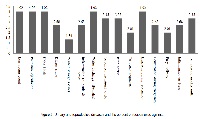Herbal Recipes used by traditional healers towards Reproductive and Urinary healthcare in Wayanad (Kerala) India.
Keywords:
Traditional medicine, Urinary and reproductive diseases, Traditional recipe, Wayanad districtAbstract
The traditional healers in Wayanad (Kerala), India possess rich aboriginal herbal medicinal knowledge (AHMK). This investigation has brought in to light many valuable therapeutic measures which were at the verge of extinction. Validation and documentation of some of such valuable in formation was hence done in order to conserve at least a part of this aboriginal ethno medicinal heritage. The study consists of three consecutive phases. In the first phase a methodology for the study including work plan was elucidated. A field level testing of the method was executed at a selected study site. In the second phase an extensive data collection cum field appraisal long three calendar years commences from July 2010 to July 2013 was conducted. In the final and third phase, validation and recording of the valid responses was done. A total of 60 species distributed in 56 genera belong to 38 families were identified being used in 67 recipes meant for 15 reproductive and urinary healthcare measures in Wayanad (Kerala), India. 31 herbs, 28 trees, 22 climbers and 16 shrubs were among the medicinal constituents. The therapeutic ingredients includes Fresh whole plants (12), dried whole plant (08), fresh root (2), dry root (29), fresh tuber (01), dried tuber (17), fresh bark (01), dried bark (02), fresh leaves (04) dried leaf (01), dried stem (01), dried petiole (01), pith powder (01), dried gum (2), fresh inflorescence (01), dried inflorescence (01), fresh flower (03), dried stamen (01), dried fruits (07), dried seeds (11), and seed oil (01). Validity stands maximum when FPVS was four and minimum when FPVS was two. Among the 67 medicinal recipes 59 has highest FPVS and the remaining 08 has mediocre FPVS. Many of the aboriginal herbal medicinal cultures (AHMC) and the associated therapeutic knowledge and practices still alive in the district are at the verge of extinction. The present study hence pivots around the conservation issues of this aboriginal medicinal heritage, particularly in the cure and management of urinary and reproductive ailments. This improves and sustains the aboriginal therapeutic system to contribute better to the national health repository.
References
Arora, S.; An introduction to Ethno botany of Nepal. Journal of Economic and Taxonomic Botany. Scientific Publishers, Jodhpur, India, pp 40-45, 1997. Asima, C.; Sathyesh, C. The treatise of Indian medicinal plants. Publication and Information Directorate, CSIR, New Delhi, pp 25-29, 1991. Binu, T.; Rajendran, A. Less known Ethno medicinal plants used by Kurichar Tribe of Wayanad District, South Western Ghats, Kerala India. Botany Research International 2013; 6 (2), 32-35. Birendra, M.; Dhurva, P.; Gauchan, B.; Ran, B. An ethno botanical study of Medicinal plants used by ethnic people in Parbat district of western Nepal. Journal of Ethnopharmacology 2015; 165: 103-117. Bruhn, J.G.; Helmstead, B. Ethno pharmacology: Objectives, principles and perspectives. -Natural products as medicinal agents. (Eds.) Beal. J.L. and Reinhard, E . Planta Medica 1981; 71: 405-430. Cheryl, A.L..Ethno medicine used in Trinidad and Tobago for urinary problems and Diabetes. Journal of Ethno biology and Ethno medicine 2006; 2 : 45-48. Cotton, C.M. Ethno botany, Principles and Applications. John Wiley and Sons, New York, pp.40-46, 1996. Deviprasad, G.; Shyma T. B. Traditional Herbal Remedies used for management of Reproductive disorders in Wayanad district, Kerala. International Journal of Pharmacy and Chemistry 2014; 4 (2) : 333-341. Dilipkumar, E.K.; Janardhana, G.R. Ethno botanical Polypharmacy of Traditional Healers in Wayanad (Kerala) with activity against type 2 diabetes. Indian Journal of Traditional Medicine 2012; 11 (4): 667-673. Hamilton, A. The people and the plant initiative. Martin, G.J.; Chapman and Hall, London, pp 88-90, 1995. Heinrich, N.; Ripler, H.; Antonio, B.N. Indigenous phytotherapy of gastrointestinal disorders in lowland Mixe Community (Oaxaca, Mexico): ethno pharmacological evaluation.Journal of Ethnopharmacology 1992; 36(1): 63-80. Li, W.L.; Zheng, H.C.; Bukuru, J.; De Kimpe, N. Natural medicines used in the Chinese medical system for therapy of diabetes mellitus. Journal of Ethnopharmacology 2004; 92:1-21. Muthu, C.; Ayyanar, M.; Raja, N.; Ignacimuthu, S. Medicinal plants used by traditional healers in Kancheepuram District of Tamil Nadu, India. Journal of Ethno biology and Ethno medicine 2006; 2: 43-45. Narayanan, N.; Swapna, M.P.; Anil, K.N. Gender dimensions of wild food management in Wayanad, Kerala. Community agro biodiversity centre publications. M.S. Swaminathan research foundation, Wayanad, Kerala, pp 28-30, 2004. Narayan, M. K..; Anil, K. Gender knowledge and changing trends in utilization of Wild edible greens in Western Ghats. Indian Journal of Traditional Medicine 2007; 6 (1): 204- 216. Rao, K. Database of Medicinal plants in Karnataka state, Karnataka State Council for Science and Technology, Bangalore, India, pp 35-38, 2000. Schultes, R.E. Trapping our Heritage of Ethno botanical Lore. Journal of Economic Botany 1960; 4(4): 257-262. Silja, V.P.; Samitha V.K. Ethno medicinal plant knowledge of the Mullu Kuruma tribe of Wayanad district, Kerala. Indian Journal of Traditional Medicine 2008; 7 (4): 604-612. Subramanian, R.; Newmaster, G.S.; Murugesan, M.; Balasubramanian, M.; Velusamy, R.; Muneer, M.; Ul-H. Consensus of the Malasars Traditional Aboriginal knowledge of medicinal plants in the Vellingiri Holy hills, India. Journal of Ethno biology and Ethno medicine 2007; 4: 8-10.



